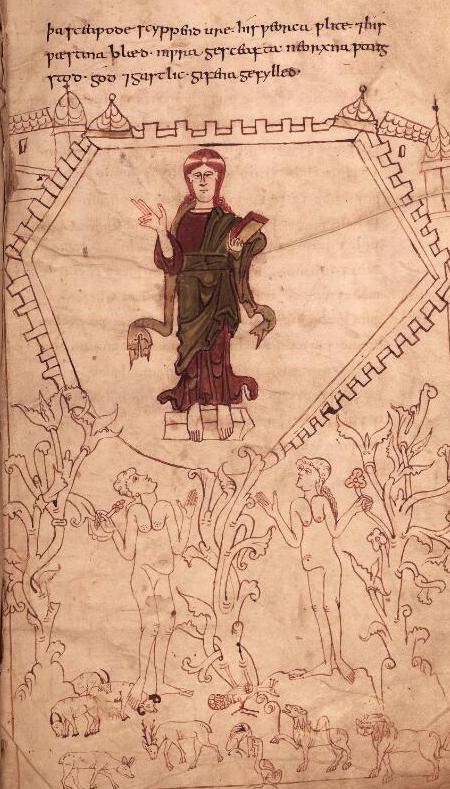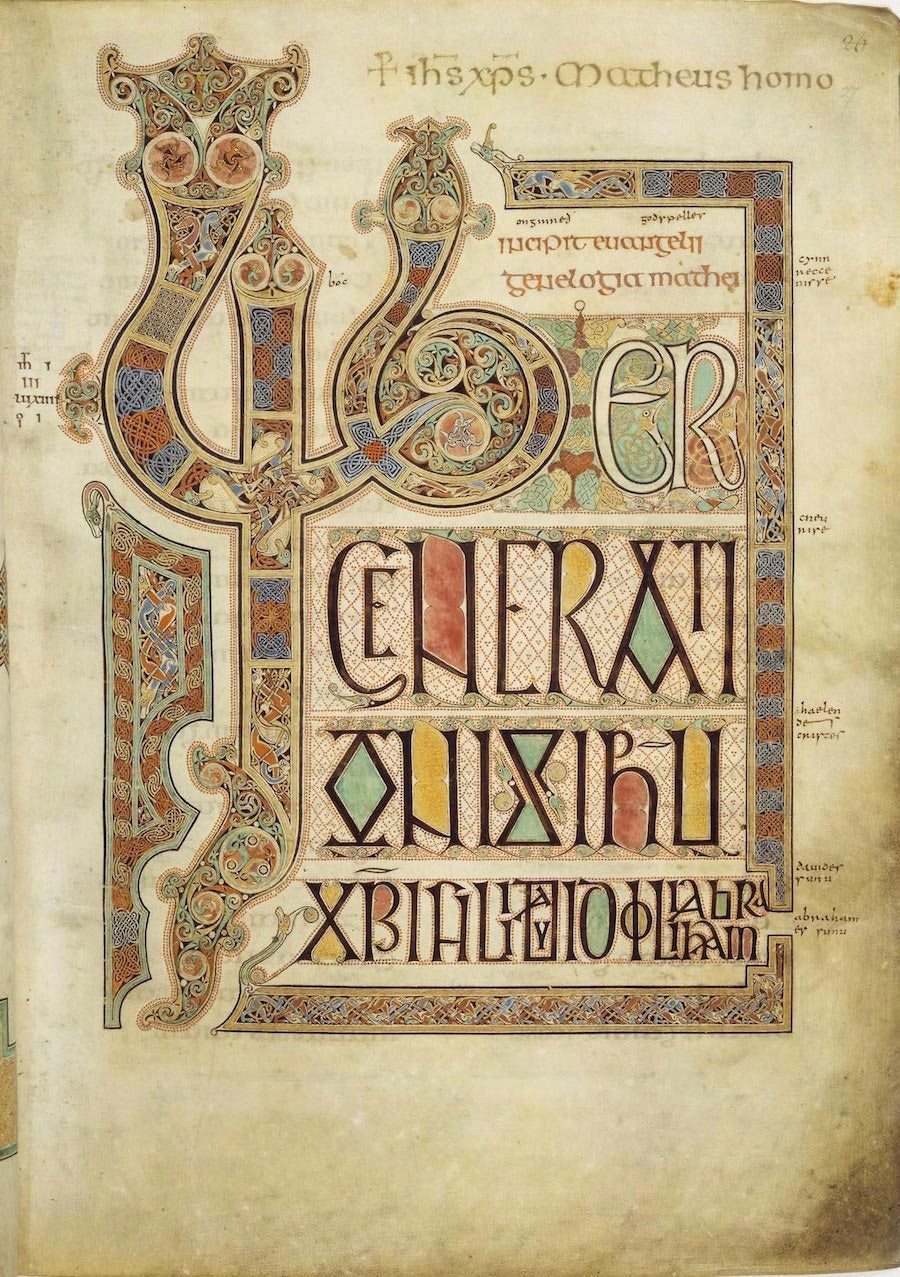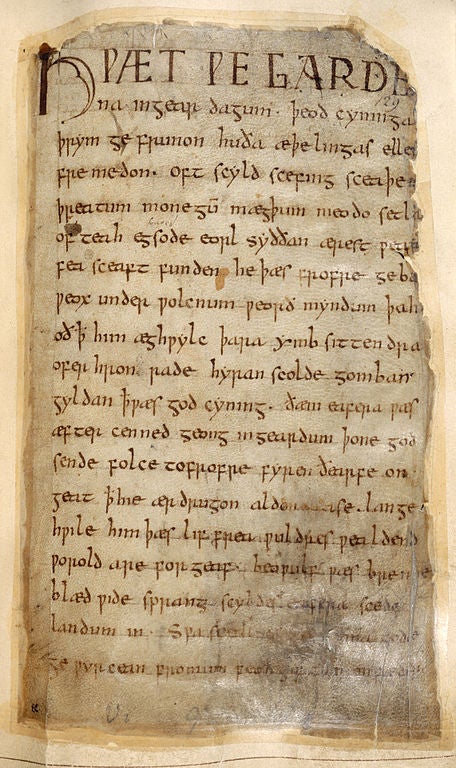“Old English,” also termed “Anglo-Saxon,” was and is simply the form of the English language that predates the Norman Conquest of 1066. The first line of the earliest poem in Old English, a prayer called “Cædmon’s Hymn,” largely unfamiliar to modern English speakers, offers a taste of this forgotten language: Nu sculon herigean heofonrices weard (“Now we must praise the guardian of the heaven-kingdom”).
Scattered American antiquarians and scholars, including Thomas Jefferson, investigated Anglo-Saxon in the early years of the American republic. The study of the language became more widespread in the decades following the Civil War, when many of the growing numbers of American universities and colleges added it to their curricula. As with any endeavor in nineteenth-century higher education, many more men than women took part.
The first generations of female students, however, took advantage of the academic respectability provided by Anglo-Saxon, with some leveraging the knowledge to enter the academic profession as faculty. Between the Civil War and World War I, Anglo-Saxon provided upper-middle-class white women with entry into the tiny ranks of female professors—and the much larger corps of female K-12 classroom teachers.
At the same time, however, the study of Anglo-Saxon played a part in the more general cultural belief—prevalent at the time—in the superiority of northern European or “Anglo-Saxon” whiteness. In 2017, as the American neo-Nazi movement that calls itself the “alt-right” is resurrecting medievally tinged celebrations of “European heritage” as part of its racist agenda, twenty-first-century Anglo-Saxonists need to confront the racism inherent in the history of the discipline. The challenge is to communicate Anglo-Saxon history as part of a multicultural and inclusive public discourse.
The Gendered History of Learning Old English
The male professors who led the field of Anglo-Saxon studies in the late nineteenth century emphatically defined English Philology—the study of Anglo-Saxon and Middle English—as a scientific, empirical subject that was also (appropriately) masculine. The study of Anglo-Saxon thus allowed nineteenth-century women to engage in quasi-objective processes of grammatical description and translation, as opposed to more belletristic appreciation of literary texts, a potentially emotional and “feminine” activity considered better suited to the parlor than the library or classroom.
In an 1884 essay in the journal of the newly formed Modern Language Association, H.C.G. Brandt, professor of French and German at Hamilton College, differentiated between “scientific” and “natural” methods of language study, explicitly equating “natural” instruction with “the mother” and “the nursery.” Brandt insisted that he and his colleagues were “modern-language-men” whose scientific methods allowed “our profession [to] gain dignity and weight.” Once they were able to access instruction in these scientific methods, women students of philology entered into and benefitted from this patriarchal culture.
Women’s colleges that sought to prove their academic rigor thus offered Anglo-Saxon. Girls’ academies and seminaries that sought to become full-fledged colleges added Anglo-Saxon to their catalogs. Some of these women’s colleges did “feminize” the Anglo-Saxon class: They included the Anglo-Saxon “women’s poems”—Judith, Juliana, and Elene—in their curricula. (Those texts were not part of the syllabus at the equivalent men’s schools.) Before World War I, at least 32 women’s colleges throughout the United States offered Anglo-Saxon; these range from Smith College in Massachusetts to the Florida State College for Women (now the coeducational Florida State University) to Mills College in California. Many graduates of these colleges became classroom teachers in K-12 schools, providing staffing for the growing numbers of public schools throughout the U.S.
Female college graduates and advanced-degree holders who had expertise in Anglo-Saxon were able to enter the female professoriate as English professors, though they were employed almost exclusively at women’s colleges. The growing number of coeducational colleges and universities at the end of the nineteenth century actually worked against the development of women faculty, since women were only very rarely hired to teach men, while men were routinely hired to teach women. Women faculty hired by coeducational universities in the U.S. were confined to teaching in the “ladies” or “domestic science” departments; women who wished to teach natural sciences, history, mathematics, or Anglo-Saxon had to do so at colleges exclusively for women.
One caveat: In the late nineteenth century, there was no concept of a woman “having it all” or “achieving work-life balance.” Female college professors were unmarried, a testimony to the era’s unwavering cultural position that a marriage and a profession were incompatible for women. Despite their advanced degrees, these professors were referred to as “miss” rather than “doctor” or “professor,” so that both their gender and marital status would remain clear at all times. Anglo-Saxon, then, provided much-needed academic respectability and professional access to a segment of first-wave feminists in the U.S.
Troubling Racial Connotations
Outside the university, however, the phrase “Anglo-Saxon” did not refer to early medieval English. Instead, it was racial and racist, freighted with assumptions of privilege and superiority. The cultural rhetoric of Manifest Destiny specifically defined “Anglo-Saxons” as superior to enslaved and free Africans, Native American Indians, Mexicans, and numerous other groups defined as non-white, including Irish and Italian immigrants. The titles of college courses in Anglo-Saxon also carried these racial connotations and cultural associations.
These racist associations stemmed from the medievalism and Anglo-Saxonism bred by nineteenth-century racial and political theorists, who used supposedly scientific and religious proposals to argue for the superiority of the Anglo-Saxon race. Those theories buttressed discourse around the Norman Conquest in the Confederacy before and after the Civil War.
Before the war, Southerners tended to identify with the Normans and their feudalism in a historically inaccurate way that seemed to justify slavery and celebrate an idealized, implicitly white Southern womanhood, defining a distinctly Southern form of “chivalry.” After the war, Southerners switched their Norman Conquest allegiance to the Anglo-Saxons, the losers, the invaded, who still managed to hold onto their core identities and customs in the face of occupation. One odd effect of this Southern Anglo-Saxonism is the use of Anglo-Saxon names in the Deep South; as one example, the 1880s Mississippi congressman Ethelbert Barksdale was named after the first Anglo-Saxon Christian king of Kent, who ruled from 589 to 616 C.E.
By 1900, most Anglo-Saxon professors probably would not have agreed with or even contemplated the idea that their discipline contributed to a racist worldview. Consider, however, 1916 remarks by M. Carey Thomas, Anglo-Saxon professor, dean, and later president of the all-women’s Bryn Mawr College. In an address to the college, later printed in its newsletter, she said:
If the present intellectual supremacy of the White races is maintained, as I hope that it will be for centuries to come, I believe it will be because they are the only races that have seriously begun to educate their women… almost all of our student body are early time Americans… Our Bryn Mawr College students therefore as a whole seem to belong by heredity to the dominant races.
In 1903, Thomas raised money for a scholarship to send the valedictorian of Philadelphia High School for Girls to Cornell. It was a tradition that the high school’s valedictorian attend Bryn Mawr on scholarship, but the valedictorian that year, Jessie Fauset, was African-American. Thomas rigorously enforced Bryn Mawr’s unwritten policy that the college was open only to white students.
The study of Anglo-Saxon at Bryn Mawr illustrates the overt and implicit racism at the turn to the twentieth century that prioritized “Anglo-Saxon” whiteness over all other racial categories. Within the university—and within the English department—that racism, if not necessarily enthusiastically embraced, was at least tolerated and certainly not contradicted.
The positioning of Anglo-Saxon as the core of the collegiate English curriculum thus silently perpetuated racist mythologies about Manifest Destiny and the superiority of Northern European ancestry. The transition of the course title from “Anglo-Saxon” to “Old English” (largely complete by the 1920s), however, helped to move the subject away from those associations.
The Teaching of Old English Today
Through the twentieth century, English departments across the U.S. moved away from requiring Old English. Most students and faculty now know Old English literature only in translation, if at all.
A number of contemporary medieval scholars have called attention to the ways that earlier nineteenth-century medievalism and racism are being rejuvenated by the American neo-Nazis, who claim to glorify the “greatness” of their “European heritage.” Crucial to the academic argument against this movement is vociferous insistence that the Middle Ages were never a celebration of white male aristocratic heroism, despite American popular perception of white knights in shining armor riding their warhorses through England and France.
Long before the Black Lives Matter movement on campuses across the country called for a more inclusive, more diverse curriculum, the discipline of medieval studies had been working toward the establishment of a “multicultural Middle Ages,” a way out from under the field’s reputation as thoroughly dead, white, and male. Since the 1980s, women authors, audiences, and subjects have been more frequently included in the field—part of the influence of second-wave feminism. Work on the Islamic Middle Ages has made its way from specialized journals into undergraduate textbooks. And the study of medieval Africa and the medieval Far East is on a similar, though slower, trajectory into recognition.
Weekly Digest
A recent historical novel for young adults, Adam Gidwitz’s The Inquisitor’s Tale, features a diverse trio of teenagers: William is the mixed-race son of a French knight and a North African woman; Jacob is Jewish; and Jeanne is a peasant. It won a Newbery honor in 2017, suggesting that the multicultural Middle Ages have reached the mainstream. When Gidwitz’s vision of the Middle Ages becomes broadly accepted—in movies about King Arthur and on TV shows like Game of Thrones—then the attempted neo-Nazi coup will have failed, despite the implicit assistance it received from the study of Old English more than a hundred years ago.










